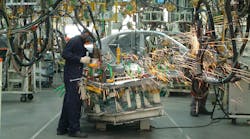Durable goods orders showed an increase in February, after two consecutive monthly decreases, as reported by the U.S. Census Bureau on March 26.
New orders increased $3.7 billion or 1.4% to $277.9 billion.
This followed a 6.9% January decrease.
Excluding transportation, new orders increased 0.5%. Excluding defense, new orders increased 2.2%. Transportation equipment, also up following two consecutive monthly decreases, led the increase, $2.9 billion or 3.3% to $90.4 billion.
Bernard Yaros, lead US economist for Oxford Economics offered this analysis:
Durable goods orders advanced in line with expectations in February as the volatile segment of aircraft orders was no longer a major drag. More importantly, core capital goods orders, a useful gauge of the underlying trend in capital spending, rose in line with our above-consensus expectations, breaking a two-month streak of declines.
Within core orders, orders for everything from fabricated metal products to machinery and motor vehicles and parts were up, but orders for computers and electronic products were notably weak, though we don't expect this to persist given several tailwinds from artificial intelligence and cloud computing to fiscal policy.
The baseline forecast calls for real equipment spending to decline by 1.3% annualized in Q1, but the incoming data on durable goods shipments and other source data suggest our forecast for equipment investment is a touch too optimistic. Our real-time estimate of real equipment spending looks for a larger 2.7% annualized drop in Q1 due in part to stronger inflation tied to capital equipment.
Real equipment spending will experience subdued growth this year but should pick up the pace meaningfully in 2025. The Federal Reserve will be in the midst of a rate-cutting cycle, lending standards for commercial and industrial loans will have become less restrictive, and the factory construction boom will increasingly bleed into new orders for computers and electronics.



